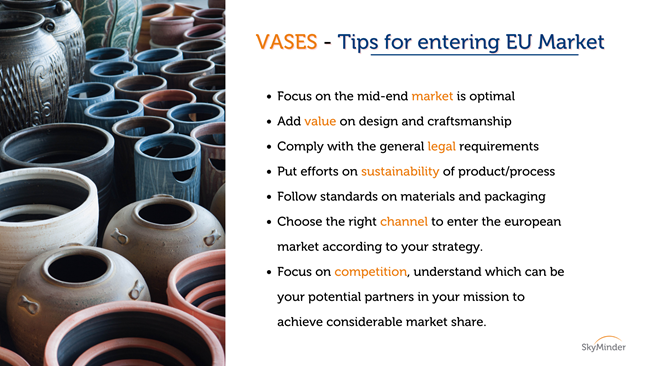Analysis and Studies - Products analysis
Vases - EU Market Analysis
February 15th 2022
The Product and the EU market
The EU market for vases offers opportunities, but competition is strong. Mass producing countries dominate the lower ends of the market, thus a focus on the mid-end market would be optimal. These consumers care about aspects and values like design, craftsmanship and sustainability, so it can be sometimes necessary to integrate these in the product or value proposition.
Legal requirements
Legal requirements are the ones that typically apply to these kinds of products in Europe. Thus, when other countries aim at exporting to a European country, they should comply with the following legal requirements: General Product Safety Directive, REACH, Timber Regulation, Packaging and Packaging Waste Directive.
Additional requirements suitable for good entrance
First, sustainability is a valuable addition that customers appreciate. It can be deployed in sustainable raw materials and production processes, or by specifying the impact of the product on the environment. There are standards and schemes to comply with; in addition, customers are more and more interested in looking for ethical and socially responsible products, and this can be seen also in this industry.
Linked to what has just been said, materials and consumer packaging are important. Wooden crating, for example, have already been banned. Biodegradable packaging materials can be a market opportunity.

Main channels of the European market
The channels of distribution in the vases market are the traditional ones: either importers/wholesalers supply to retailers, or larger retail chains import themselves; or, the small retailers buy directly from the supplier. In some cases, buying and sales agents can play a role. E-commerce, for the most developed companies, can be an option.
The right channel to be chosen differ according to the target customers the company has, the relationship duration it wants to achieve with suppliers or distributors, ecc. Overall, the preferred solutions are exporting to retailers in EU countries through wholesale importers, or in case of larger importers with no intermediation of wholesalers.
Competition
Europe’s leading supplier is China, that produces above all following mass production to lower-end segments. China provides more than 40% of the imports, and Germany follows at a distance with 10%.
As it has been said, China dominates the low-end market. Among the growing countries, Poland is strengthening a lot its position in the EU region. Vietnam is another low-cost producer as China. Even if this country does not have the same market share, they represent an effective second-sourcing alternative to China.
Just to have an idea of other countries, India has a stable market share, Czech Republic has profited a lot of its convenient location and Portugal is specialized in ceramics.
